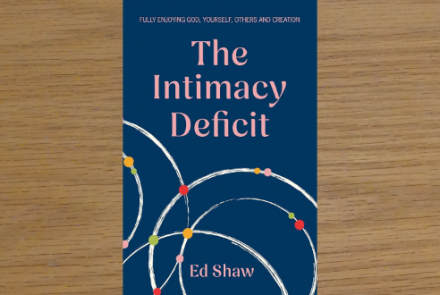A brief critique of Queer Theology
Note: This article is more technical than most of our articles. This is because at True Freedom Trust we are seeking to equip all Christians to rebut false teaching effectively.
Introduction
This article offers a brief critique of the movement known as queer theology, by analysing two of its main distinctive features. These two distinctive features are firstly the broadness of queer theology and secondly, its aim of blurring boundaries in the areas of sex and gender.
Distinctive One - Broadness and Unity
One key distinctive of queer theology is how broad the movement is and yet how an overarching goal unites it. I will define the goal as a ‘…revision of the church’s understanding of the Bible, sexual morality and the meaning of marriage.’[1]
The broadness of queer theology can be seen by contrasting scholars such as Brooten, who acknowledge that the Scriptures condemn same-sex practice but in doing so argue that they should be ‘disregarded,'[2] with those who are supposedly more ‘evangelical’ in their approach.
An evangelical[3] approach can be seen through the arguments of Vines[4] who seeks to show that the Scriptures do not prohibit all forms of same-sex sexual expression. Instead, Vines asserts that ‘Christians who affirm the full authority of Scripture can also affirm committed, monogamous same-sex relationships.’[5] The approach of Vines and others is often argued by attempting to show that the explicit references to same-sex practice in the Scriptures should not be taken as applicable to modern, committed same-sex relationships.
Others, like Rudy, would not seek monogamy or commitment as a moral principle for which to strive. Rudy, for example, claims that non-monogamous sex can be viewed as a hospitable, progressive ethic.[6] Two additional scholastic positions further highlight the different approaches to monogamy. Wilson, on the more liberal wing, talks of ‘bodily hospitality’[7] where promiscuity is considered a gift, whereas Jeffrey John articulates an approach which talks of same-sex relationships being ‘permanent, faithful and stable.'[8] John is seeking what he sees as equal rights for same-sex couples, whereas Wilson is celebrating a more expressive sexuality. One approach wants a seat at the table of societal institutions such as marriage, whereas the other is happy to tip the table over. Both, however, have a minimal aim of encouraging others to see same-sex practice as honourable to God.
The broadness of this movement is also seen in the contrast between two other influential scholars. Someone who seeks to argue from the Bible for faithful same-sex relationships is James Brownson, who states ‘my… commitment to the centrality of Scripture has not changed’. [9] We can contrast Brownson’s approach with that of Adrian Thatcher. Thatcher makes it plain that his books are ‘always written from a progressive, liberal perspective’ with the aim of helping to make churches ‘more inclusive.'[10] One must, therefore, wonder how objectively Thatcher is treating the Scriptures when his conclusions seem to be predetermined by his aim.
Thatcher, Brownson, Vines, and Wilson all highlight the broad and varying hermeneutical approaches taken within the sphere of queer theology. The broadness of queer theology gives it a regrettably broad reach. Both the more liberal and conservative ends of queer theology, however, have serious flaws, which mitigate against it being considered a useful hermeneutic.
The more conservative wing of queer theology has failed in its attempt to reconcile a high view of Scripture with a consistent hermeneutical approach that highlights how and why the Biblical prohibitions on same-sex practice are no longer applicable. Even if this were achieved, however, it would still be in danger of arguing from silence as there are no positive references to same-sex practice in the Scriptures. It is hard to reconcile arguments from silence with what many deem to be a ‘high view’ of Scripture. Wilson argues that biblical narratives such as David and Jonathan affirm an LGBT experience.[11] Scholars have, however, widely rejected Wilson’s claims as a use of decontextualization and false appropriation.[12]
The work of theologians like Brooten highlights how weak the more evangelical wing of this movement is. Brooten’s work highlights that it is not just exploitative relationships which fall under Paul’s condemnation in Romans 1.[13]
Romans 1 is a good place to see how weak many ‘affirming’ positions are. Arguments regarding excessive lust and only exploitative relationships being in view are incoherent due to the mutuality of the language, for example, the ‘one another’ (εἰς ἀλλήλους) in verse 27, and Paul’s mention of female same-sex practice in verse 26. We can also see that the phrase ‘contrary to nature’ verse 26 (παρὰ φύσιν) is clearly established within the context of the creation account. It comes, for example, amongst an intertextual echo of the Septuagint creation account in verse 23, and overt references to creation such as ‘the creation of the world’ (κτίσεως κόσμου) in verse 20, and ‘the Creator’ in verse 25. This establishes the universal sinfulness of same-sex practice, rather than as merely a culturally limited prohibition.
No scholastic approach from within queer theology has been widely recognised as a viable ‘affirming’ exegesis of the passage in question. Indeed, dodging the truth of the Scriptures is such a difficult task among ‘gay affirming’ scholars that many like Brooton, Loader, MacCulloch, Wink, Luke Timothy Johnson and others, accept the Scriptural prohibitions on same-sex activity. They simply look for creative ways to get around these truths. As, Loader notes, therefore, for many queer theologians, the hermeneutical question overrides the exegetical one.[14]
The common hermeneutical approach of queer theology has often manifested itself as a form of liberation theology, which sees some texts as oppressive.[15] To take this approach would mean that the subjective will always be in the driving seat. One problem with this is that due to a predetermined ideological commitment, as already seen from Thatcher, queer theology seeks to stop God from speaking on his own terms through Scripture.
Distinctive Two – Erasing Boundaries
The second key distinctive of queer theology is its desire to erase boundaries, especially the boundary of gender.[16] Building on the work of Butler, who sees gender roles as socially constructed and performative,[17] binary categories of gender are collapsed within queer theology. As in feminist hermeneutics, the truth of gender complementarity is attacked across the broad spectrum of queer theology.[18]
Since gender complementarity is attacked within queer theology, we need to analyse a key argument against complementarianism. Egalitarian Scripture readings often seek out progressive projections within Scripture regarding the role of women. Scholars such as Webb, however, have shown that a redemptive-movement hermeneutic like that deployed to argue for egalitarianism, should not be neatly applied to the area of same-sex practice. This is because there is a different kind of movement regarding homosexuality and the Scriptures. It is ‘an absolute movement’ which leads from same-sex practice being ‘widely accepted within the broader culture… to a complete ban on same-sex activity’ within the Scriptures.[19]
Queer theology often takes the deconstruction of gender roles one step further than classical feminists through transgender ideology. We should, therefore, also ask ourselves what cost the deconstruction of gender/sex has within queer theology. There are structured binaries within the creation account, for example, land and sea, night and day, heavens and earth, male and female. Indeed, an accurate rendering of the word kə·neḡ·dōw in the creation account, derived from neged would be ‘corresponding to,’ describing ‘a perfect complement.'[20] Wright talks about these structured binaries playing a larger narrative role within the Scriptures. [21]
Granted, the existence of night and day does not outlaw the existence of dusk, but the use of binaries within creation should steer us away from treating the binaries of male and female as mere repressive social constructs. They are, in fact, important narrative aspects within the Scriptures. With its hands tied by its agenda, therefore, queer theology should be critiqued as a useless and damaging hermeneutic which is committed to a reading of the text which minimises important narrative aspects within the Scriptures.
I will conclude our evaluation of this boundary erasing distinctive by noting that queer theology has another interesting tension at its heart. Far from building on the work of Foucault and ridding itself of identity labels and makers such as gay or LGBTQ,[22] many within the movement have embraced these labels, possibly as a way of highlighting minority repression or creating a robust identity and subculture. Perhaps the reason that this identity boundary has not been blurred but upheld is that it is advantageous to the aims of queer theology to keep it in place. It is precisely these identities which often help to shape the theology of the individual.
Speaking of Christians who identify as gay, Yarhouse claims ‘identity and behaviour came first, and their beliefs and values had to be adjusted to them’[23] and this also seems to be the case within queer theology. The ideology drives the theological outcomes. Clearly, it is beneficial for us to engage with our bias and allow the Scriptures to challenge our preconceptions. In contrast, queer theology puts a predetermined bias in place and only reads the Scriptures through it.
Conclusion
I have explored two key distinctive features of queer theology. Although its broadness and unity of purpose enables queer theology to reach a wide range of people, there are obvious tensions at its heart. The more conservative wing fails in its task of providing an exegetical foundation to celebrate same-sex relationships, and the more liberal side tends to disregard Scripture.
Unfortunately, queer theology has itched the ears (2 Timothy 4:3) of many in the West. As a result of its success and the changes in Western society, it may also mean that queer theology will have to remodel itself if it wants to remain a countercultural movement which ‘queers’ boundaries and has a so called ‘prophetic edge.'[24] Through its success, therefore, queer theology may have sown the seeds of its demise. This demise could come about as it is harder to thrive as a counter-cultural movement when the Western culture has changed to become increasingly accepting of LGBT relationships.[25]
What, then, should the response of faithful Christians be too queer theology? Well, surely, we must conserve the truth which has been handed down to us. The truth of God’s definition of sexual sin which was established in the Scriptures and has been unchallenged for thousands of years of Church history. We must gently instruct those who oppose this truth in the hope that God will grant them repentance. Along with conserving the truth of God’s word, we must also be liberal in our proclamation of the true gospel. The gospel which upholds God’s definition of sin and holds out the prospect of salvation for all who turn to him in faith and repentance through Christ.
Those faithful Christians who have responded to the true gospel, like members of True Freedom Trust, those who experience same-sex temptations but remain faithful to Christ, those who are now the true counter-cultural insurgency, are also starting to take a stand and make their stories heard. Along with exposing the folly of movements such as queer theology, their stories are surely one of the best ways of combatting this form of false teaching.
Notes
[1] See chapter one of Mohler, God and the, Chapter 1. Although this definition is aimed at the more ‘evangelical’ wing of queer theology, it is fair to apply this as a minimal aim for the whole movement.
[2] See Brooten, Love, 294, cited in Gagnon, The Bible and.
[3] This term is being used to describe those like Brownson, who claim to be committed to the original meaning of Scripture.
[4]Although Vines is not a scholar, his work has been influential. In his early presentations Vines borrowed heavily from Boswell, but has since changed to lean more on the work of Brownson.
[5] See Vines, God and the Gay, Introduction.
[6] See Rudy, Sex and the Church, 108-130 cited in Radical Love.
[7] Wilson, Our Tribe, 231-280 cited in Radical love.
[8] See John, Permanent Faithful Stable.
[9] Brownson, Bible Gender, Introduction. His notion of moral logic, however, works in a way which projects his own morality onto the Scriptures.
[10] See Thatcher’s Amazon author page https://www.amazon.co.uk/Adrian-Thatcher/e/B00N87MZ0K.
[11] Wilson, Our Tribe, 111-164.
[12] See Fee and Stuart, how to read the Bible, The Old Testament Narratives.
[13] Referenced in Gagnon, The Bible and, The Witness of Paul.
[14] Loader, sexuality, chapter 2.
[15] Fiorenza, The Will to Choose, 130.
[16] See Cheng, Radical Love, God: The sending Forth.
[17] See Radical Love, Queer terminology.
[18] See Brownson, Bible Gender, Chapter 2 Analysing Gender Complementarity.
[19] Webb, Slaves, 39.
[20] Busenitz http://legacy.tms.edu/tmsj/tmsj19h.pdf.
[21] Wright https://www.youtube.com/watch?v=xKxvOMOmHeI.
[22] Cheng, Radical Love, Queer Terminology, Queer as Erasing Boundaries.
[23] Yarhouse, Homosexuality, 51.
[24] Goss, Queering Christ, 228-29, cited in Radical Love.
[25] Multiple research supports this. For US attitudes see Twenge, ‘Archives.’
References
Brooten, B., Love Between Women: Early Christian Responses to Female Homoeroticism. Chicago: University of Chicago Press 1996.
Busenitz, I.A., Marriage and Homosexuality: Toward A Biblical Understanding, http://legacy.tms.edu/tmsj/tmsj19h.pdf accessed on 24/03/17.
Brownson, J., Bible Gender Sexuality Reframing the Church’s Debate on Same-Sex Relationships. Grand Rapids: Wm. B. Eerdmans Publishing Co: 2014. [Digital]
Cheng, P, S., An Introduction to Queer Theology, Radical love. New York: Seabury Books, 2011. [Digital]
Gagnon, A, J., The Bible and Homosexual Practice, Texts and Hermeneutics. [Digital]
Goss, R.E., Queering Christ: Beyond Jesus Acted Up. Cleveland: Pilgrim Press, 2002.
John, J., Permanent, Faithful, Stable: Christian Same-sex Marriage. Darton, Longman & Todd, 2012.
Fee, G, Stuart, D., How to Read the Bible for all its Worth. Zondervan, 2014. [Digital]
Fiorenza, E.S., The Will to Choose or to Reject: Continuing Our Critical Work, in Russell, L. (ed Feminist Interpretation of the Bible. Blackwell, 1985.
Loader, W., Sexuality in the New Testament, Understanding the Key Texts. London: SPCK, 2010. [Digital]
Mohler, A, et al., God and the Gay Christian? A Response to Matthew Vines. Louisville: SBTS Press, 2014. [Digital]
Rudy, K., Sex and the Church: Gender Homosexuality, and the Transformation of Christian Ethics. Boston: Beacon Press, 1990.
Thatcher, A., (Author Biography, 25th March 2017 https://www.amazon.co.uk/Adrian-Thatcher/e/B00N87MZ0K)
Twenge, J.M. et al., Archives of Sexual Behavior, October 2016, Volume 45, Issue 7, pp 1713–1730, ‘Changes in American Adults’ Reported Same-Sex Sexual Experiences and Attitudes, 1973–2014.'
Vines, M., God and the Gay Christian. Convergent Books, 2014. [Digital]
Vines, M., The Gay Debate, (23rd March 2017 https://www.youtube.com/watch?v=ezQjNJUSraY)
Webb, W, J., Slaves, Women & Homosexuals. Exploring the Hermeneutics of Cultural Analysis. IVP, 2001.
Wilson, N., Our Tribe: Queer Folks, God, Jesus and the Bible. HarperCollins, 1995.
Wright, N.T. On Gay Marriage, (20th March 2017 https://www.youtube.com/watch?v=xKxvOMOmHeI)
Yarhouse, M., Homosexuality and the Christian, A Guide for Parents, Pastors, and Friends. Bethany House Publishers, 2010.






